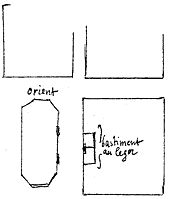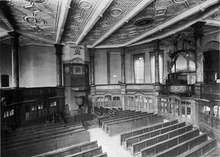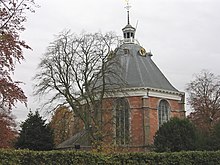Walloon-Dutch Church
The Walloon-Dutch Church in Hanau was the double reformed denomination of the new town of Hanau, founded in 1597 by Count Philipp Ludwig II of Hanau-Münzenberg for religious refugees from France and the Spanish Netherlands .
history
Originally from Nicolas Gillet planned to place the churches within the lines of the block development. The circular building between four blocks of houses was to be supported by twelve columns and provided with four entrances. However, plans were already made in early summer 1597. The church should now have a large church square and stand free.
After a collection for the building of the church had begun in January 1599 , the Dutch and Walloons reached an agreement in August of the same year: a double church should be built because of the bilingual nature of the refugee community ( Dutch and French ). The denominational unity was expressed through the close connection between the two churches, which were to be "separated by a good wall" inside.
These plans were massively defended against Philip Ludwig II by Daniel Soreau , among others . In a letter dated February 11, 1600, he asked René Mahieu to get a model and show it to the Count in order to convince him. He argued that the Flemings , who would be heavily involved in funding the church, needed to be satisfied. He also recommended building a makeshift building to bridge the time of construction. This light construction ( bastiment au leger ), which is also outlined in the letter, could later be converted into residential houses and sold at a profit.
However, the count was not convinced and the construction of a round church was planned - despite the concerns of the community representatives about the additional costs. The model is said to have been the church of Wilhelmstadt in the Netherlands, which - like the Neustadt Hanau - was built as a planned town at this time. It is believed that the count saw this church on a trip shortly before this decision. The church was ultimately erected as a solitary building on a square the size of a square of houses (today: Französische Allee ), which took up the same area as the market square . The foundation stone was laid on April 9, 1600, to which famous personalities such as Frederick IV and Luise Juliana of Orange were invited. The construction work was marked by a constant lack of money and technical difficulties. Since a large part of the construction time would be used for the larger Walloon part of the church, the Flemings wanted to build their part from their own resources without the help of the Walloons. These in turn wanted to erect a wooden makeshift temple on the market square ( de Borse ) that was planned previously , where Philipp Ludwig now wanted to build the town hall. Because of differences between Stadtschultheiß Dr. Wilhelm Sturio and treasurer Wilhelm Post, however, did not approve the building. However, it would be another 120 years before the town hall would stand on this square. The exterior work was finally completed with the first service on October 29, 1608, and the interior work continued for several years.
The Walloon-Dutch Church in Hanau was dominated by the huge pitched roofs of the two halves of the church. The larger Walloon church was formed from a dodecagon , the smaller Dutch one from an octagon. Both were intertwined. Between the two churches, in the middle of the partition wall, stood the octagonal tower, which was relatively subordinate to the mighty hipped roofs . Inside, both churches were simply furnished as Reformed houses of God.
local community
The congregation belonged to the Evangelical Reformed Church (regional church) from 1996 to 2008 , but has been independent again since then. Originally, the separation from the also reformed regional church of the County of Hanau-Münzenberg was probably due to the linguistic difference. The Walloon-Dutch congregation then did not participate in the Hanau Union , which resulted in a denominational difference: it remained reformed, the regional church became united . In the course of the 19th century and the first half of the 20th century, German increasingly became the language of worship. After the Second World War, services were only held in German.
As an independent church and recognized corporation, the Walloon-Dutch congregation is a member (Signatarkirche) of the Community of Evangelical Churches in Europe (CPCE) and locally a member of the Working Group of Christian Churches (ACK), which it currently chairs (2016).
In 2016, a new community center was built not far from the church in Gärtnerstrasse, which also houses the church administration.
Destruction and rebuilding
During the Second World War , the double church was destroyed by air raids - like the entire city center of Hanau - except for the outer walls. Only the smaller, formerly Dutch half of the church was rebuilt after the war. The larger, Walloon one was preserved as a ruin and memorial. In the 1980s, a community and diaconal center and a memorial were built there at ground floor level - barely noticeable from the outside . In 1988 Walter Kromp received the Main-Kinzig-Kreis art award for the design. The combination of a monument and the use of the ruin in accordance with the requirements of the monument received the Hessian Monument Protection Prize in 1988 .
Combination organ
The organ system is designed as a so-called "hybrid" or " combination organ ". It comprises a conventional pipe organ with 25 registers on two manuals and a pedal from the 1960s, which was expanded in 2010 with a digital organ and a new console.
The pipe organ is set up on the west gallery. The digital organ has 48 registers and 11 effect registers, which can be played from a four-manual console on the side gallery. It is designed as a general console so that it can also be used to play the pipe organ at the same time. In addition, registers are stored as files in the digital instrument 110. The sound of the digital organ is transmitted into the church through 45 loudspeakers, including 3 sub-bass woofers, which enable the organ to sound in 3D surround. The loudspeaker system is set up on the right and left flanking the pipe organ.
|
|
|
|
|
|||||||||||||||||||||||||||||||||||||||||||||||||||||||||||||||||||||||||||||||||||||||||||||||||||||||||||||||||||||||||||||||||||||||||||||||||||||||||||||||||||||||
- Couples: I / II, III / II, IV / II, III / I, IV / I, I / P, II / P, III / P, IV / P and four unison off couplers
- Effect and solo registers: chimes, glockenspiel, harp, celesta, cymbal star , trumpet, pan flute, oboe, clarinet, tuba, strings
literature
- Heinrich Bott: Foundation and beginnings of the new town of Hanau 1596–1620. Marburg 1970, ISBN 3-7708-0409-0 , pp. 225ff.
- Heinrich Bott: City and fortress Hanau. In: Hanauer Geschichtsblätter 20, 1965, pp. 61–125.
- Georg Dehio : Handbook of the German art monuments - Hessen . Arranged: Magnus Backes. 2nd edition, Munich 1982.
- Eckhart Fischer-Defoy: Refuge - Hanau (= conference publication for the 32nd German Huguenot Day). Hanau 1981.
- Opening of the Diakoniezentrum of the Kathinka Platzhoff Foundation and the handover of the new memorial to the Walloon-Dutch community . Hanau 1987.
- Consistory of the Walloon-Dutch Congregation: Our Church - memorial for the anniversary celebration of the Walloon-Dutch Congregation in Hanau on June 3rd, 4th and 5th, 1972. Looking back over 375 years . Hanau 1972.
- Werner Kurz: "Mother" of the Walloon-Dutch Church . In: Hanauer Anzeiger , September 8, 2007, p. 33.
- Friedrich Otto: The Walloon and Dutch community in Hanau . In: Hanau city and country. A home book for school and home . Hanau 1954, pp. 460-464.
- JP Thyriot: Festschrift to commemorate the 300th anniversary of October 29, 1608, on which the first service in the Walloon u. Dutch double church in the Neustadt Hanau took place . Hanau 1908.
Web links
Website of the Walloon-Dutch community Hanau
Individual evidence
- ↑ a b Bott [1965], p. 76f
- ↑ Bott [1970], p. 229
- ↑ Gemeindeblatt March / April / May 2008 memorial as a reminder of the destruction of Hanauer Neustadt ( Memento from March 4, 2016 in the Internet Archive )
- ↑ Hanauer Anzeiger July 1, 2006 32nd day of the Hessian monument preservation in Hanau
- ↑ More information on the combination organ
Coordinates: 50 ° 7 '53 " N , 8 ° 55' 1.2" E







